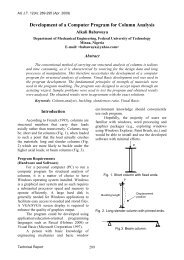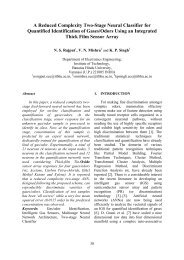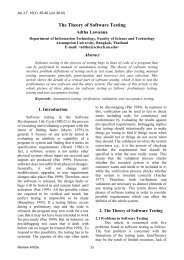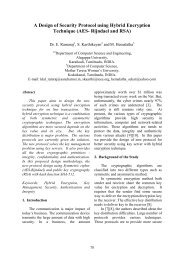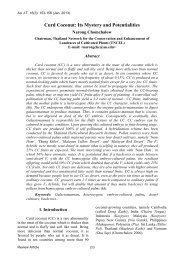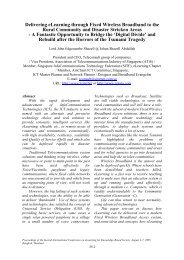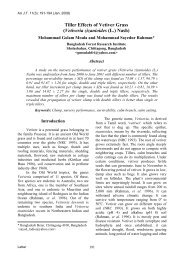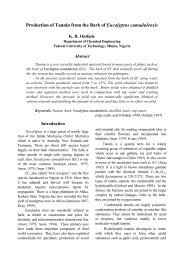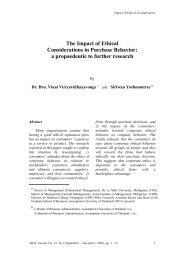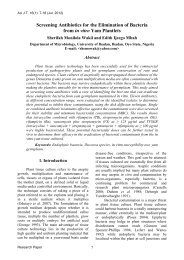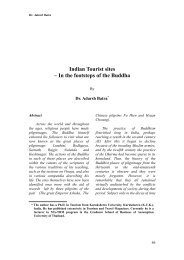Zeolites - Earliest Solid State Acids - AU Journal
Zeolites - Earliest Solid State Acids - AU Journal
Zeolites - Earliest Solid State Acids - AU Journal
Create successful ePaper yourself
Turn your PDF publications into a flip-book with our unique Google optimized e-Paper software.
<strong>AU</strong> J.T. 11(1): 36-41 (Jul.2507)<br />
In classical zeolites the silicon or<br />
aluminum atoms are surrounded by four<br />
oxygen anions forming an approximate<br />
tetrahedron. The apex tetrahedral metals are<br />
called T-atoms. These tetrahedra stack in<br />
regular arrays and form channels. Stacking<br />
possibilities are virtually limitless giving<br />
hundreds of unique structures.<br />
The zeolitic channels (or pores) are<br />
microscopically small (molecular size<br />
dimensions) and are therefore called<br />
"molecular sieves". The size and shape of the<br />
channels influence the adsorption properties of<br />
these materials making them useful in<br />
separation processes. Molecules can be<br />
separated via shape and size effects related to<br />
their possible orientation in the pore, or by<br />
differences in adsorption strength.<br />
Silicon is typically in a 4+ oxidation state<br />
and the silicon-oxygen tetrahedra are<br />
electrically neutral. But aluminum in zeolites<br />
exists in the 3+ oxidation state, making anionic<br />
zeolite frameworks. To maintain electrical<br />
neutrality cations populate the pores. These<br />
“compensating” cations participate in ionexchange<br />
processes, and give some important<br />
properties to zeolites. "Soft" cations such as<br />
sodium make zeolites excellent water softeners<br />
because they can replace the "hard" magnesium<br />
and calcium cations in water. If protons are the<br />
compensating cations, the zeolite becomes a<br />
strong solid acid. Such solid acids are the basis<br />
of zeolite catalysis, including the fluidized-bed<br />
cat-cracking refinery process. Other metal<br />
cations can also populate the pores giving<br />
unique catalytic materials. Thus zeolites are<br />
also used in "shape-selective catalysis".<br />
The nature of acid sites in zeolites and<br />
the factors that influence enhanced catalytic<br />
activity have been of much interest. Whether<br />
all of acid sites are homogeneous or<br />
heterogeneous in acid strength requires<br />
quantifying the acidity. In this context, density<br />
functional theory (DFT) becomes crucial. For<br />
example, investigation of the reactivity of the<br />
acid sites in the zeolite chabazite (SSZ-13)<br />
revealed that the proton affinities of the four<br />
acidic oxygens at the aluminum T-site are all<br />
roughly the same. The deprotonation energy is<br />
not connected to the O-H bond length or the<br />
vibrational stretch frequency. The strength of<br />
the acid sites in chabazite is not influenced<br />
significantly by chemical or structural<br />
variations in the framework near the acid site.<br />
Applications<br />
A wide variety of industrial applications<br />
of zeolites, mainly catalysis and separations,<br />
exist. Development of the methanol to gasoline<br />
(MTG) process by Mobil in the 1970's<br />
(increased gasoline yield from each barrel of<br />
crude oil by 50 percent and improved octane<br />
number) (ExxonMobil 2007) and development<br />
of methanol to olefins (MTO) process by<br />
UOP/Hydro in 1996 (UOP/Hydro 2007)<br />
spurred petrochemical zeolite applications.<br />
Heterogeneous catalysts have an edge over<br />
liquid-phase processes. Waste minimization,<br />
wide range of possible process operating<br />
conditions, and ease of product separation are<br />
some advantages.<br />
However, solid-acid catalysts cannot<br />
replace all industrial homogeneous catalysts.<br />
Difficulties in reactant and product diffusion to<br />
and from the zeolite surface in the absence of a<br />
solvent are a major obstacle.<br />
There are three main zeolites industrial<br />
applications: catalysis, gas separation and ion<br />
exchange (Lentech 2007). A more detailed<br />
description is available elsewhere (Wikipedia<br />
2007).<br />
Catalysis (Lentech 2007): This is the<br />
most important application. Several important<br />
organic reactions are catalyzed by zeolites. The<br />
most important are cracking, isomerisation and<br />
hydrocarbon synthesis. A diverse range of<br />
catalytic reactions including acid-base and<br />
metal induced reactions can be promoted by<br />
zeolites. The reactions occur within the zeolite<br />
pores and allow greater product control.<br />
Hydrogen-exchanged zeolites, whose<br />
framework-bound protons yield very high<br />
acidity, form an important class of catalysts.<br />
Many organic reactions, including crude oil<br />
cracking, isomerisation and fuel synthesis use<br />
this type of zeolite catalyst. <strong>Zeolites</strong> can also<br />
catalyze oxidation or reduction, often after<br />
metals have been introduced into the<br />
framework. For example titanium ZSM-5 is<br />
Review Article 37



